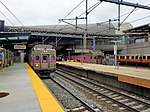Center for High-rate Nanomanufacturing
The Center for High-rate Nanomanufacturing ("CHN") at Northeastern University provides capabilities for the fabrication and study of nano-products, nanoscale materials and nanoscale manufacturing processes. Established in Boston in 2004 by the US National Science Foundation, the CHN's nanomanufacturing research program is creating new processes for making nanoproducts and aiding in the design of specific nanoproducts, such as sensors, biomedical devices, or batteries. The NSF Nanoscale Science and Engineering Center for High-rate Nanomanufacturing (CHN) is one of four nanoscale engineering research centers funded by the NSF. Since 2004, the CHN has carried out over $50 million in research funded by NSF, government agencies, foundations and the private sector. It has affiliated scientists and researchers at Northeastern University, University of Massachusetts-Lowell, University of New Hampshire, Michigan State University and the Museum of Science. The founding director and principal investigator is Dr. Ahmed Busnaina. Research is carried out in several fields: directed assembly and transfer of nanoparticle, environmental health & safety for nanomanufacturing, and regulatory & ethical issues related to nanoproducts.
Excerpt from the Wikipedia article Center for High-rate Nanomanufacturing (License: CC BY-SA 3.0, Authors).Center for High-rate Nanomanufacturing
Huntington Avenue, Boston Fenway / Kenmore
Geographical coordinates (GPS) Address Website Nearby Places Show on map
Geographical coordinates (GPS)
| Latitude | Longitude |
|---|---|
| N 42.3376 ° | E -71.089 ° |
Address
Northeastern University
Huntington Avenue 360
02115 Boston, Fenway / Kenmore
Massachusetts, United States
Open on Google Maps







